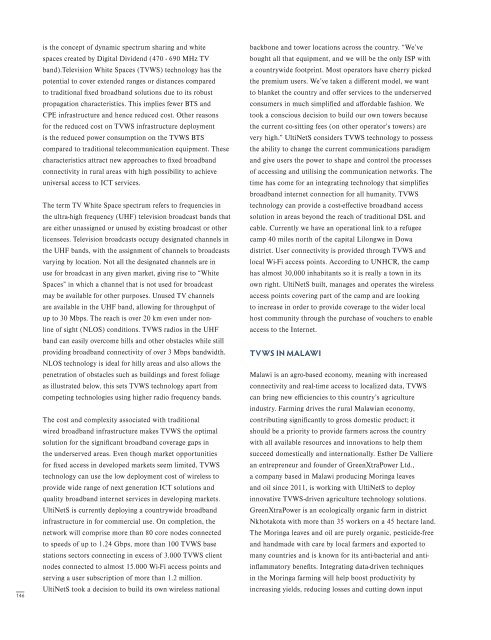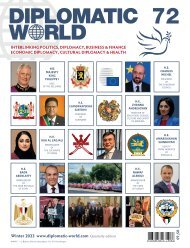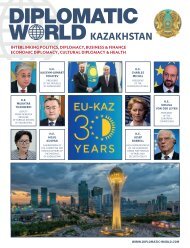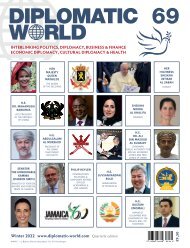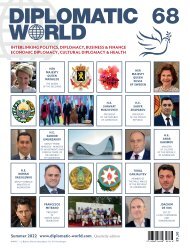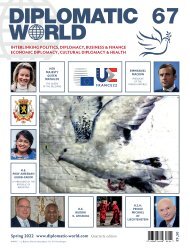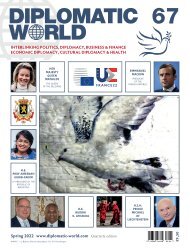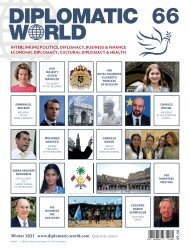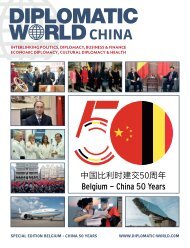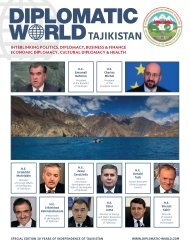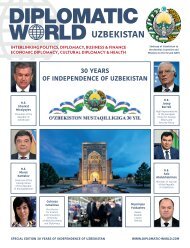Diplomatic World_nummer 57
You also want an ePaper? Increase the reach of your titles
YUMPU automatically turns print PDFs into web optimized ePapers that Google loves.
146<br />
is the concept of dynamic spectrum sharing and white<br />
spaces created by Digital Dividend (470 - 690 MHz TV<br />
band).Television White Spaces (TVWS) technology has the<br />
potential to cover extended ranges or distances compared<br />
to traditional fixed broadband solutions due to its robust<br />
propagation characteristics. This implies fewer BTS and<br />
CPE infrastructure and hence reduced cost. Other reasons<br />
for the reduced cost on TVWS infrastructure deployment<br />
is the reduced power consumption on the TVWS BTS<br />
compared to traditional telecommunication equipment. These<br />
characteristics attract new approaches to fixed broadband<br />
connectivity in rural areas with high possibility to achieve<br />
universal access to ICT services.<br />
The term TV White Space spectrum refers to frequencies in<br />
the ultra-high frequency (UHF) television broadcast bands that<br />
are either unassigned or unused by existing broadcast or other<br />
licensees. Television broadcasts occupy designated channels in<br />
the UHF bands, with the assignment of channels to broadcasts<br />
varying by location. Not all the designated channels are in<br />
use for broadcast in any given market, giving rise to “White<br />
Spaces” in which a channel that is not used for broadcast<br />
may be available for other purposes. Unused TV channels<br />
are available in the UHF band, allowing for throughput of<br />
up to 30 Mbps. The reach is over 20 km even under nonline<br />
of sight (NLOS) conditions. TVWS radios in the UHF<br />
band can easily overcome hills and other obstacles while still<br />
providing broadband connectivity of over 3 Mbps bandwidth.<br />
NLOS technology is ideal for hilly areas and also allows the<br />
penetration of obstacles such as buildings and forest foliage<br />
as illustrated below, this sets TVWS technology apart from<br />
competing technologies using higher radio frequency bands.<br />
The cost and complexity associated with traditional<br />
wired broadband infrastructure makes TVWS the optimal<br />
solution for the significant broadband coverage gaps in<br />
the underserved areas. Even though market opportunities<br />
for fixed access in developed markets seem limited, TVWS<br />
technology can use the low deployment cost of wireless to<br />
provide wide range of next generation ICT solutions and<br />
quality broadband internet services in developing markets.<br />
UltiNetS is currently deploying a countrywide broadband<br />
infrastructure in for commercial use. On completion, the<br />
network will comprise more than 80 core nodes connected<br />
to speeds of up to 1.24 Gbps, more than 100 TVWS base<br />
stations sectors connecting in excess of 3.000 TVWS client<br />
nodes connected to almost 15.000 Wi-Fi access points and<br />
serving a user subscription of more than 1.2 million.<br />
UltiNetS took a decision to build its own wireless national<br />
backbone and tower locations across the country. “We’ve<br />
bought all that equipment, and we will be the only ISP with<br />
a countrywide footprint. Most operators have cherry picked<br />
the premium users. We’ve taken a different model, we want<br />
to blanket the country and offer services to the underserved<br />
consumers in much simplified and affordable fashion. We<br />
took a conscious decision to build our own towers because<br />
the current co-sitting fees (on other operator’s towers) are<br />
very high.” UltiNetS considers TVWS technology to possess<br />
the ability to change the current communications paradigm<br />
and give users the power to shape and control the processes<br />
of accessing and utilising the communication networks. The<br />
time has come for an integrating technology that simplifies<br />
broadband internet connection for all humanity. TVWS<br />
technology can provide a cost-effective broadband access<br />
solution in areas beyond the reach of traditional DSL and<br />
cable. Currently we have an operational link to a refugee<br />
camp 40 miles north of the capital Lilongwe in Dowa<br />
district. User connectivity is provided through TVWS and<br />
local Wi-Fi access points. According to UNHCR, the camp<br />
has almost 30,000 inhabitants so it is really a town in its<br />
own right. UltiNetS built, manages and operates the wireless<br />
access points covering part of the camp and are looking<br />
to increase in order to provide coverage to the wider local<br />
host community through the purchase of vouchers to enable<br />
access to the Internet.<br />
TVWS IN MALAWI<br />
Malawi is an agro-based economy, meaning with increased<br />
connectivity and real-time access to localized data, TVWS<br />
can bring new efficiencies to this country’s agriculture<br />
industry. Farming drives the rural Malawian economy,<br />
contributing significantly to gross domestic product; it<br />
should be a priority to provide farmers across the country<br />
with all available resources and innovations to help them<br />
succeed domestically and internationally. Esther De Valliere<br />
an entrepreneur and founder of GreenXtraPower Ltd.,<br />
a company based in Malawi producing Moringa leaves<br />
and oil since 2011, is working with UltiNetS to deploy<br />
innovative TVWS-driven agriculture technology solutions.<br />
GreenXtraPower is an ecologically organic farm in district<br />
Nkhotakota with more than 35 workers on a 45 hectare land.<br />
The Moringa leaves and oil are purely organic, pesticide-free<br />
and handmade with care by local farmers and exported to<br />
many countries and is known for its anti-bacterial and antiinflammatory<br />
benefits. Integrating data-driven techniques<br />
in the Moringa farming will help boost productivity by<br />
increasing yields, reducing losses and cutting down input


